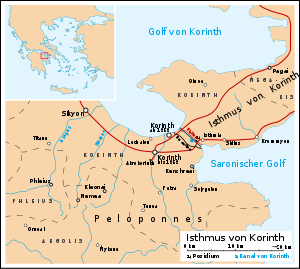Battle of Solygeia
| date | 425 BC Chr. |
|---|---|
| place | in Corinthian |
| output | controversial victory of Athens |
| Parties to the conflict | |
|---|---|
| Commander | |
|
Lycophron †, Battos |
|
| Troop strength | |
| 2,000 Attic hoplites , over 1,000 allies, 200 horsemen, 80 ships |
half the exodus from Corinth, no horsemen |
| losses | |
|
50 fallen |
212 dead |
The Battle of Solygeia was a battle in the Peloponnesian War that took place in 425 BC. In the area of Corinth between an invading army from Athens and local defenders. The Athenians won, but withdrew before the arrival of enemy reinforcements.
strategy
Weakened by the outbreak of the plague , Athens adhered to a less risky strategy of pinpricks in the first few years after the death of Pericles, with unexpected landings on the coast of the Peloponnese , rapid looting and early retreat before the defenders could muster their strength. Such an undertaking was carried out in the summer of 425 by the Attic general Nicias against Corinth.
March
Nikias sailed with 80 ships into the Saronic Gulf and landed with his army between Kenchreai and Rheiton in the area of Corinth. He led 2,000 Attic hoplites and three auxiliary contingents of the allies from Miletus , Andros and Karystos . Since he also had a number of horse transporters in his fleet, there were also 200 riders.
The Corinthians, however, had got wind of the Athenian project from Argos and were therefore deployed with the entire contingent on the isthmos north of Kenchreai. After landing, the two armies were initially separated by Mount Oneios and the Chersonese promontory. During the night the Corinthians and half of their crew went around the mountain, sent a detachment under the command of General Battos to the unsurfaced village of Solygeia in the south to defend themselves, and with the rest of them under the command of their general Lycophron to fight. The other half of their army initially stayed in Kenchreai to guard the isthmos and the northern Krommyon.
Course of the battle
The troops of Lycophron first threw themselves on the right wing of the Athenians in front of Chersonese. The Athenians and Karystier received the shock and laboriously pushed them back against the mountain. When another division came to the aid of the Corinthians, the Athenian line retreated to the sea. When they arrived at the ships, however, the Athenians and Karystier turned back again, renewing the struggle. On the right wing of the Corinthians, Lycophron fought to keep the left wing of the Athenians from advancing into Solygeia. The two sides held each other for a long time, but since the Corinthians had no riders, the Athenian cavalry finally tipped the balance. Pursued by the Attic cavalry, the Corinthians fled to a nearby hill. In doing so, Lycophron fell with many others. The Athenians took the weapons of the slain, recovered their own dead and erected a victory mark. The number of Corinthians killed was 212, the Athenians had almost 50 fallen.
retreat
The other Corinthians had heard nothing of the battle behind the mountain, and only when they noticed the cloud of dust did they hurry to help. When the Athenians saw them coming, Nicias ordered embarkation and withdrew to the nearby islands. Here he noticed that two dead had been left behind because they were not found. He then asked the Corinthians to surrender the corpses, although according to military and political practice this had to be interpreted as a renunciation of victory. From the islands, Nicias went on to Krommyon, where his troops ravaged the land, and in the days that followed they did the same to Epidaurus and Troizen .
consequences
Sybota - Potidaia - Spartolus - Stratos - Naupactus - Plataea - Olpai - Tanagra - Pylos - Sphacteria - Corinth - Megara - Delion - Amphipolis - Mantinea - Melos - Syracuse - Miletus - Syme - Eretria - Kynossema - Abydos - Kyzikos - Ephesus - Chalcedon - Byzantium - Andros - Notion - Mytilene - Arginus - Aigospotamoi
The Battle of Solygeia was an example of Nicias' cautious strategy in a war of attrition as planned by Pericles. The important decisions were meanwhile brought about by generals willing to take risks in other locations, in particular in the Battle of Pylos and the subsequent Battle of Sphakteria and three years later in the Battle of Amphipolis .
Individual evidence
- ↑ Thucydides , IV 42-45; Plutarch , Nicias , VI.

